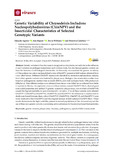Mostrar el registro sencillo del ítem
Genetic variability of Chrysodeixis includens nucleopolyhedrovirus (ChinNPV) and the insecticidal characteristics of selected genotypic variants
| dc.creator | Aguirre Sánchez, Eduardo | es_ES |
| dc.creator | Beperet Arive, Inés | es_ES |
| dc.creator | Williams, Trevor | es_ES |
| dc.creator | Caballero Murillo, Primitivo | es_ES |
| dc.date.accessioned | 2020-03-05T12:00:15Z | |
| dc.date.available | 2020-03-05T12:00:15Z | |
| dc.date.issued | 2019 | |
| dc.identifier.issn | 1999-4915 | |
| dc.identifier.uri | https://hdl.handle.net/2454/36420 | |
| dc.description.abstract | Genetic variation in baculoviruses is recognized as a key factor, not only due to the influence of such variation on pathogen transmission and virulence traits, but also because genetic variants can form the basis for novel biological insecticides. In this study, we examined the genetic variability of Chrysodeixis includens nucleopolyhedrovirus (ChinNPV) present in field isolates obtained from virus-killed larvae. Different ChinNPV strains were identified by restriction endonuclease analysis, from which genetic variants were isolated by plaque assay. Biological characterization studies were based on pathogenicity, median time to death (MTD), and viral occlusion body (OB) production (OBs/larva). Nine different isolates were obtained from eleven virus-killed larvae collected from fields of soybean in Mexico. An equimolar mixture of these isolates, named ChinNPV-Mex1, showed good insecticidal properties and yielded 23 genetic variants by plaque assay, one of which (ChinNPV-R) caused the highest mortality in second instars of C. includens. Five of these variants were selected: ChinNPV-F, ChinNPV-J, ChinNPV-K, ChinNPV-R, and ChinNPV-V. No differences in median time to death were found between them, while ChinNPV-F, ChinNPV-K, ChinNPV-R and ChinNPV-V were more productive than ChinNPV-J and the original mixture of field isolates ChinNPV-Mex1. These results demonstrate the high variability present in natural populations of this virus and support the use of these new genetic variants as promising active substances for baculovirus-based bioinsecticides. | en |
| dc.description.sponsorship | This research was funded by the Ministerio de Economía y Competitividad; grant number AGL2014-57752-C2-1-R. E.A. received an UPNA studentship and I.B. received a Torres-Quevedo grant. | en |
| dc.format.extent | 14 p. | |
| dc.format.mimetype | application/pdf | en |
| dc.language.iso | eng | en |
| dc.publisher | MDPI | en |
| dc.relation.ispartof | Viruses, 2019, 11 (7), 581 | en |
| dc.rights | © 2019 by the authors. Licensee MDPI, Basel, Switzerland. This article is an open access article distributed under the terms and conditions of the Creative Commons Attribution (CC BY) license. | en |
| dc.rights.uri | http://creativecommons.org/licenses/by/4.0/ | |
| dc.subject | Genetic variants | en |
| dc.subject | Plaque assay | en |
| dc.subject | Bioassay | en |
| dc.subject | Pathogenicity | en |
| dc.subject | Speed-of-kill | en |
| dc.subject | Bioinsecticide | en |
| dc.title | Genetic variability of Chrysodeixis includens nucleopolyhedrovirus (ChinNPV) and the insecticidal characteristics of selected genotypic variants | en |
| dc.type | info:eu-repo/semantics/article | en |
| dc.type | Artículo / Artikulua | es |
| dc.contributor.department | Institute for Multidisciplinary Research in Applied Biology - IMAB | es_ES |
| dc.rights.accessRights | info:eu-repo/semantics/openAccess | en |
| dc.rights.accessRights | Acceso abierto / Sarbide irekia | es |
| dc.identifier.doi | 10.3390/v11070581 | |
| dc.relation.projectID | info:eu-repo/grantAgreement/MINECO//AGL2014-57752-C2-1-R/ES/ | en |
| dc.relation.publisherversion | https://doi.org/10.3390/v11070581 | |
| dc.type.version | info:eu-repo/semantics/publishedVersion | en |
| dc.type.version | Versión publicada / Argitaratu den bertsioa | es |



